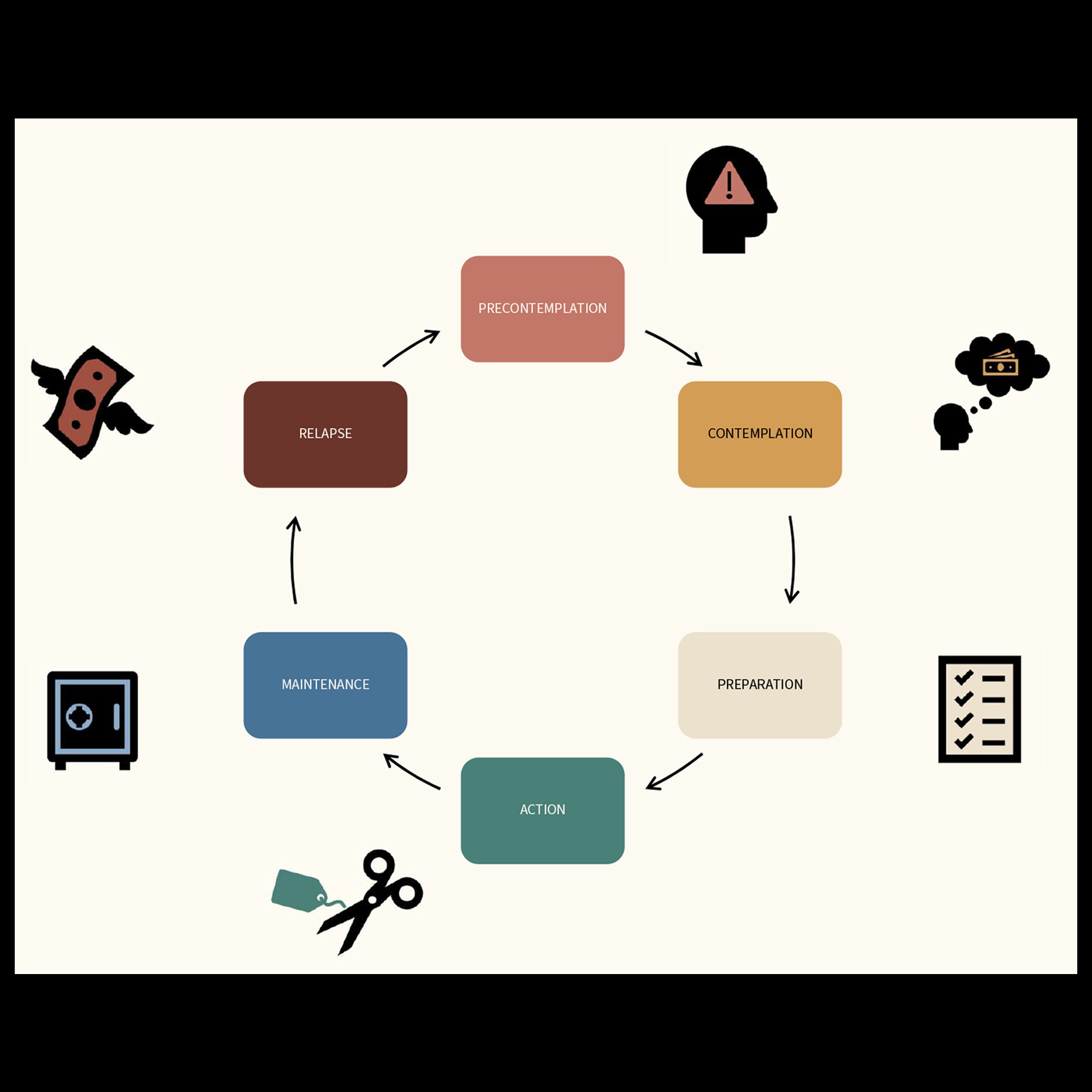Navigate the Cycle of Change for Health and Wealth
Adapted from the Transtheoretical Model by Prochaska & DiClemente (1983).
We’ve heard it and lived it so many times—change is hard! Whether it’s diet, finance, health, or any habit-based activity, there is no doubt that making a change to our behavior is often complex and challenging.
Unfamiliarity, new skillsets and habits, a loss of old standbys, and other reluctant or unsure thinking patterns can all play a factor in the difficulty of making a change, but another aspect to manage is the fact that while we change, our needs and lives are also changing. Let’s take a deeper look through the lens of the “Cycle of Change,” a therapeutic model for patients in different stages of change.
The Cycle of Change focuses on the decision-making of an individual making an intentional change, to help identify what stage we are in and therefore target the appropriate techniques for support suited to that stage. It is viewed as a cyclical process to address habitual behavior, which assumes that our behavior does not change quickly or decisively, but rather over time and continuously.
The six stages in the model include pre-contemplation, contemplation, preparation, action, maintenance, and relapse. The stages provide a roadmap, guiding us from recognizing the need for change to taking action and maintaining the change over time. Identifying where we are, understanding what we need, and then working to effectuate the change based on those parameters can help us stay on track with our goals for health and wealth.
The 6 Stages of Change
1. Precontemplation: In this stage, the individual is yet to be made aware of the need for change and may not see the problem as serious. This state is unlikely to be met with self-intervention, but helpful support for this stage includes education on the risks versus benefits of a given behavior, and exposure to the positive outcomes related to making a change. As a person moves from this stage to the next, they may perform a self-appraisal to identify what an idealized version of their own behavior looks like in their mind, independent of what they may be doing now.
2. Contemplation: In this stage, the individual begins recognizing the problem and may consider making a change. Self-support at this stage includes embracing the healthy behavior as part of a desired identity, investigating barriers and misconceptions that may hinder progress, committing to change and believing that change is possible, and identifying supportive relationships and environments that will encourage change.
3. Preparation: In this stage, the individual starts to make specific plans for change and may take small steps toward the goal. Helpful practices for support include developing realistic goals, creating a timeline for change, and preparing positive reinforcement for substituting healthy behaviors and thoughts for unhealthy ones.
4. Action: In this stage, the individual takes significant steps to make the change and actively works towards the goal. The best support in this stage includes positive reinforcement and celebration of the successful work in substituting new healthy behaviors for old unhealthy habits. As the actions continue, an individual may learn to reward positive behavior and reduce rewards that come from negative behavior.
5. Maintenance: In this stage, the individual works to maintain the change and prevent relapse. Along with rewarding the new positive behavior and reducing rewards for old negative habits, individuals will benefit from a re-engineered environment and relationships with reminders and cues that encourage and support the healthy behavior.
6. Relapse: In this stage, the individual may return to their old habits and behaviors, but with the knowledge and skills gained from previous stages, they can use this as an opportunity to learn and try again. Being aware of this stage can help individuals anticipate potential challenges and prepare for them, so they can learn and adjust their plans accordingly. The best self-support during this time is also to rely on the identified environments and relationships that support and encourage the healthy behavior and avoid those that work in service of the unhealthy behavior.
Using the Cycle of Change
The Cycle of Change can be helpful to use as a roadmap for self-support and guidance toward moving forward. The first step toward making the model work for you is to identify which stage of change you are in. Review the chart and supporting text to find your place and get to know what challenges and processes you may be facing at the moment. Develop plans for self-support by considering what would help you better face the challenges you anticipate in the stage you have identified. List these helpful tools, practices, and people for your own reference and decide how and when you would best be supported by them.
By creating an awareness of these stages and building a pathway of support that is tailored to you, you can follow the cycle to make a plan and take action to achieve your health and wealth goals, prepare for any possible relapse, and learn from it to start again. Keep in mind that everything is always changing, and try to give yourself multiple options for support and success, and go easy on any feelings of self-judgment that might come up.
In conclusion, understanding and utilizing the Cycle of Change can be valuable in achieving your health and wealth goals. By identifying where you are in the process, what support is accessible to you, and what steps you will take next, you can create a custom pathway for yourself to return to as you move forward through this undertaking of change. Remember, change is a journey and setbacks may happen, but relapse is a part of the framework, and you can be prepared and learn from any that may occur. Stay focused, stay motivated, and stay on track toward reaching your goals.od for you.

